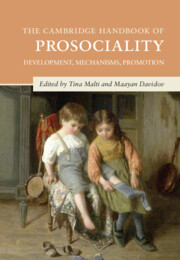Book contents
- The Cambridge Handbook of Prosociality
- Cambridge Handbooks in Psychology
- The Cambridge Handbook of Prosociality
- Copyright page
- Dedication
- Contents
- Figures
- Contributors
- Part I Development of Prosociality
- Part II Antecedents and Mechanisms of Prosociality
- Part III Development of Prosociality in Context
- Part IV Applications
- 26 Fostering Prosociality in the Family Context
- 27 Prosociality and Civic Engagement
- 28 Prosocial Behavior, Positive Youth Development, and Character Virtues
- 29 Relational Practices of Care to Nurture Prosociality and Advance Policy
- 30 Toward a New Era of Prosociality Research
- Afterword
- Index
- References
26 - Fostering Prosociality in the Family Context
A Review of Parent- and Family-Focused Interventions Promoting Children’s Effortful Control and Prosocial Tendencies
from Part IV - Applications
Published online by Cambridge University Press: 25 May 2023
- The Cambridge Handbook of Prosociality
- Cambridge Handbooks in Psychology
- The Cambridge Handbook of Prosociality
- Copyright page
- Dedication
- Contents
- Figures
- Contributors
- Part I Development of Prosociality
- Part II Antecedents and Mechanisms of Prosociality
- Part III Development of Prosociality in Context
- Part IV Applications
- 26 Fostering Prosociality in the Family Context
- 27 Prosociality and Civic Engagement
- 28 Prosocial Behavior, Positive Youth Development, and Character Virtues
- 29 Relational Practices of Care to Nurture Prosociality and Advance Policy
- 30 Toward a New Era of Prosociality Research
- Afterword
- Index
- References
Summary
The critical role of effortful control (EC) in promoting prosocial development has been consistently supported in correlation studies. Yet it remains unclear whether promoting EC can be an intermediate target through which psychological interventions promote prosocial tendencies in youth. This review focuses on how to translate basic developmental research on family influences on children’s EC into family-focused interventions. First, we review key features of family socialization associated with children’s EC. Second, we conduct a qualitative review of randomized controlled studies of family-focused interventions that have examined EC as an outcome or mediator. We review key components and formats of these interventions and their efficacy in improving EC and related youth outcomes. We also review family-focused interventions for promoting children’s prosocial tendencies. In summary, our review finds some evidence for the efficacy of family-focused interventions in improving children’s EC. Limitations of existing interventions and future directions are also discussed.
- Type
- Chapter
- Information
- The Cambridge Handbook of ProsocialityDevelopment, Mechanisms, Promotion, pp. 517 - 541Publisher: Cambridge University PressPrint publication year: 2023

